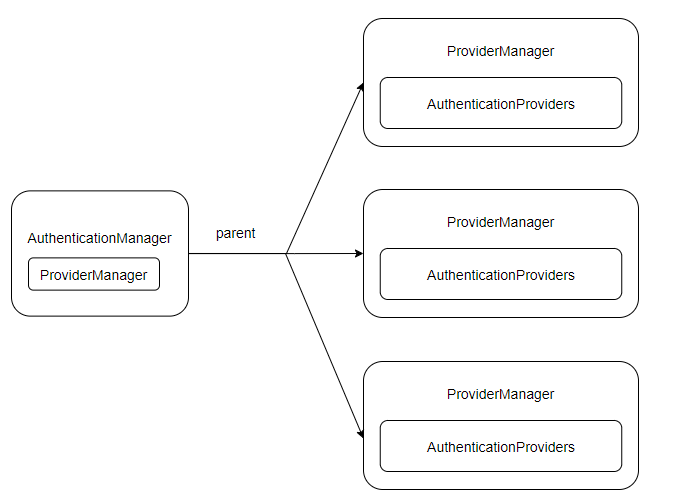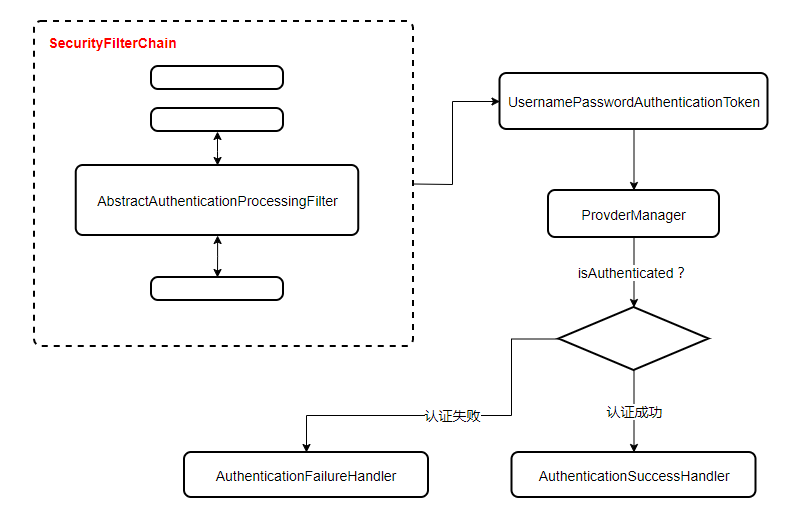登录流程分析
Spring Security 的认证流程和其三个基本组件:AuthenticationManager、ProviderManager 以及 AuthenticationProvider 有关,同时还有一个接入认证功能的过滤器 AbstractAuthenticationProcessingFilter 。
1、AuthenticationManager
顾名思义,AuthenticationManager 是一个认证管理器,它定义了 Spring Security 过滤器要如何执行认证操作。
AuthenticationManager 在认证成功后,会返回一个 Authentication 对象,这个对象会被设置到 SecurityContextHolder 中。
当然,如果开发者不想使用 Spring Security 提供的一套认证机制,那么也可以自定义认证流程,认证成功后,手动将 Authentication 存入 SecurityContextHolder 中。
源码如下:
public interface AuthenticationManager {
Authentication authenticate(Authentication authentication) throws AuthenticationException;
}AuthenticationManager 是一个接口,其中只有一个方法,它的主要作用是对传入的 Authentication 对象进行身份认证,此时传入的 Authentication 参数只有 用户名/密码 等简单的属性,如果认证成功,返回的 Authentication 对象的属性就会得到完全填充,包括用户所具备的角色信息。
该接口有诸多实现类,其中使用最多同时也是默认使用的是 ProviderManager,当然开发者也可以自定义 AuthenticationManager 的实现类。
2、AuthenticationProvider
之前提到 Spring Security 支持多种不同的认证方式,不同的认证方式对应不同的身份类型,AuthenticationProvider 就是针对不同的身份类型执行具体的身份认证。
例如,常见的 DaoAuthenticationProvider 用来支持用户名/密码登录认证,RememberMeAuthenticationProvider 用来支持 “记住我” 的认证。
源码如下:
public interface AuthenticationProvider {
Authentication authenticate(Authentication authentication) throws AuthenticationException;
boolean supports(Class<?> authentication);
}两个方法含义如下:
(1)authenticate 方法用来执行具体的身份认证;
(2)supports 方法用来判断当前的 AuthenticationProvider 是否支持对应的身份类型。
(1) AbstractUserDetailsAuthenticationProvider
当用户以用户名和密码登录时,对应的 AuthenticationProvider 实现类是 DaoAuthenticationProvider ,而 DaoAuthenticationProvider 继承自 AbstractUserDetailsAuthenticationProvider 并且没有重写 authenticate 方法,所以具体的认证逻辑是在 AbstractUserDetailsAuthenticationProvider 的 authenticate 方法中。
public abstract class AbstractUserDetailsAuthenticationProvider
implements AuthenticationProvider, InitializingBean, MessageSourceAware {
// ................
private UserCache userCache = new NullUserCache();
protected boolean hideUserNotFoundExceptions = true;
private boolean forcePrincipalAsString = false;
private UserDetailsChecker preAuthenticationChecks = new DefaultPreAuthenticationChecks();
private UserDetailsChecker postAuthenticationChecks = new DefaultPostAuthenticationChecks();
// 抽象方法,由子类完成
protected abstract void additionalAuthenticationChecks(UserDetails userDetails,
UsernamePasswordAuthenticationToken authentication) throws AuthenticationException;
// 执行认证
@Override
public Authentication authenticate(Authentication authentication) throws AuthenticationException {
Assert.isInstanceOf(UsernamePasswordAuthenticationToken.class, authentication,
() -> this.messages.getMessage("AbstractUserDetailsAuthenticationProvider.onlySupports",
"Only UsernamePasswordAuthenticationToken is supported"));
String username = determineUsername(authentication);
boolean cacheWasUsed = true;
UserDetails user = this.userCache.getUserFromCache(username);
if (user == null) {
cacheWasUsed = false;
try {
user = retrieveUser(username, (UsernamePasswordAuthenticationToken) authentication);
}
catch (UsernameNotFoundException ex) {
this.logger.debug("Failed to find user '" + username + "'");
if (!this.hideUserNotFoundExceptions) {
throw ex;
}
throw new BadCredentialsException(this.messages
.getMessage("AbstractUserDetailsAuthenticationProvider.badCredentials", "Bad credentials"));
}
Assert.notNull(user, "retrieveUser returned null - a violation of the interface contract");
}
try {
this.preAuthenticationChecks.check(user);
additionalAuthenticationChecks(user, (UsernamePasswordAuthenticationToken) authentication);
}
catch (AuthenticationException ex) {
if (!cacheWasUsed) {
throw ex;
}
// There was a problem, so try again after checking
// we're using latest data (i.e. not from the cache)
cacheWasUsed = false;
user = retrieveUser(username, (UsernamePasswordAuthenticationToken) authentication);
this.preAuthenticationChecks.check(user);
additionalAuthenticationChecks(user, (UsernamePasswordAuthenticationToken) authentication);
}
this.postAuthenticationChecks.check(user);
if (!cacheWasUsed) {
this.userCache.putUserInCache(user);
}
Object principalToReturn = user;
if (this.forcePrincipalAsString) {
principalToReturn = user.getUsername();
}
return createSuccessAuthentication(principalToReturn, authentication, user);
}
private String determineUsername(Authentication authentication) {
return (authentication.getPrincipal() == null) ? "NONE_PROVIDED" : authentication.getName();
}
// 子类实现该方法
protected Authentication createSuccessAuthentication(Object principal, Authentication authentication,
UserDetails user) {
// Ensure we return the original credentials the user supplied,
// so subsequent attempts are successful even with encoded passwords.
// Also ensure we return the original getDetails(), so that future
// authentication events after cache expiry contain the details
UsernamePasswordAuthenticationToken result = new UsernamePasswordAuthenticationToken(principal,
authentication.getCredentials(), this.authoritiesMapper.mapAuthorities(user.getAuthorities()));
result.setDetails(authentication.getDetails());
this.logger.debug("Authenticated user");
return result;
}
// ................
}AbstractUserDetailsAuthenticationProvider 是一个抽象类,抽象方法在它的实现类 DaoAuthenticationProvider 中完成,该抽象类本身逻辑也很简单:
(1)一开始先声明一个用户缓存对象 userCache,默认情况下没有启用缓存对象;
(2)hideUserNotFoundExceptions 表示是否隐藏用户名查找失败的异常,默认为 true。为了确保系统安全,用户在登录失败时只会给出一个模糊提示,例如 “用户名或密码输入错误”。在 Spring Security 内部,如果用户名查找失败,则会抛出 UsernameNotFoundException 异常,但是默认该异常会被隐藏,转而通过一个 BadCredentialsException 异常来代替它;
(3)forcePrincipalAsString 表示是否强制将 Principal 对象当作字符串处理,默认是 false。Authentication 中的 principal 属性类型是一个 Object,正常来说,通过 principal 属性可以获取到当前登录用户对象(即 UserDetails),但是如果 forcePrincipalAsString 为 true,则 Authentication 中的 principal 属性返回的就是当前用户名,而不是用户对象;
(4)preAuthenticationChecks 对象则是用于做用户状态检查,在用户认证过程中,需要检验用户状态是否正常,例如账户是否被锁定、账户是否可用、账户是否过期等等;
(5)postAuthenticationChecks 对象主要负责在密码校验成功后,检查密码是否过期;
(6)additionalAuthenticationChecks 是一个抽象方法,主要就是校验密码,具体实现在DaoAuthenticationProvider 子类中;
(7)authenticate 方法就是核心的校验方法了。在方法中,首先从登录数据中获取用户名,然后根据用户名去缓存中查询用户对象,如果查询不到,则根据用户名调用 retrieveUser 方法从数据库中加载用户;如果没有加载到用户,则抛出异常。拿到用户对象后,首先调用 preAuthenticationChecks.check 方法进行用户状态检查,然后调用 additionalAuthenticationChecks 方法进行密码的校验工作,最后调用 postAuthenticationChecks.check 方法检查密码是否过期,当所有步骤都顺利完成后,调用 createSuccessAuthentication 方法创建一个认证后的 UsernamePasswordAuthenticationToken 对象并返回,认证后的对象包含了认证主体、凭证以及角色信息。
(2) DaoAuthenticationProvider
上面就是这个抽象类进行用户认证的工作流程,有几个抽象方法是在 DaoAuthenticationProvider 中实现的,看一下源码:
public class DaoAuthenticationProvider extends AbstractUserDetailsAuthenticationProvider {
private static final String USER_NOT_FOUND_PASSWORD = "userNotFoundPassword";
private PasswordEncoder passwordEncoder;
private volatile String userNotFoundEncodedPassword;
private UserDetailsService userDetailsService;
private UserDetailsPasswordService userDetailsPasswordService;
@Override
protected final UserDetails retrieveUser(String username, UsernamePasswordAuthenticationToken authentication)
throws AuthenticationException {
prepareTimingAttackProtection();
try {
UserDetails loadedUser = this.getUserDetailsService().loadUserByUsername(username);
if (loadedUser == null) {
throw new InternalAuthenticationServiceException(
"UserDetailsService returned null, which is an interface contract violation");
}
return loadedUser;
}
catch (UsernameNotFoundException ex) {
mitigateAgainstTimingAttack(authentication);
throw ex;
}
catch (InternalAuthenticationServiceException ex) {
throw ex;
}
catch (Exception ex) {
throw new InternalAuthenticationServiceException(ex.getMessage(), ex);
}
}
@Override
@SuppressWarnings("deprecation")
protected void additionalAuthenticationChecks(UserDetails userDetails,
UsernamePasswordAuthenticationToken authentication) throws AuthenticationException {
if (authentication.getCredentials() == null) {
this.logger.debug("Failed to authenticate since no credentials provided");
throw new BadCredentialsException(this.messages
.getMessage("AbstractUserDetailsAuthenticationProvider.badCredentials", "Bad credentials"));
}
String presentedPassword = authentication.getCredentials().toString();
if (!this.passwordEncoder.matches(presentedPassword, userDetails.getPassword())) {
this.logger.debug("Failed to authenticate since password does not match stored value");
throw new BadCredentialsException(this.messages
.getMessage("AbstractUserDetailsAuthenticationProvider.badCredentials", "Bad credentials"));
}
}
@Override
protected Authentication createSuccessAuthentication(Object principal, Authentication authentication,
UserDetails user) {
boolean upgradeEncoding = this.userDetailsPasswordService != null
&& this.passwordEncoder.upgradeEncoding(user.getPassword());
if (upgradeEncoding) {
String presentedPassword = authentication.getCredentials().toString();
String newPassword = this.passwordEncoder.encode(presentedPassword);
user = this.userDetailsPasswordService.updatePassword(user, newPassword);
}
return super.createSuccessAuthentication(principal, authentication, user);
}
}在 DaoAuthenticationProvider 中:
(1)首先定义了 USER_NOT_FOUND_PASSWORD 常量,这个是当用户查找失败时的默认密码;passwordEncoder 是一个密码加密和比对工具;userNotFoundEncodedPassword 变量则用来保存默认密码加密后的值;userDetailsService 是用户查找的工具,之前也提到过;userDetailsPasswordService 则用来提供密码的修改服务。
(2)在 DaoAuthenticationProvider 的构造方法中,默认就会指定 PasswordEncoder,当然开发者也可以通过 set 方法自定义;
(3)additionalAuthenticationChecks 方法主要进行密码校验,该方法的第一个参数 userDetails 是从数据库中查询出的用户对象;第二个参数 authentication 则是登录用户输入的参数。从这两个参数中分别提取出用户密码,然后调用 passwordEncoder.matches 方法进行密码比对;
(4)retrieveUser 方法则是获取用户对象的方法,具体做法就是调用 UserDetailsService#loadUserByUsername 方法去数据库中查询;
(5)在 retrieveUser 方法中,有一个值得关注的地方。该方法一开始会调用 prepareTimingAttackProtection 方法,该方法的作用是使用 PasswordEncoder 对常量 USER_NOT_FOUND_PASSWORD 进行加密,将加密结果保存在 userNotFoundEncodedPassword 变量中。当根据用户名查找用户时,如果抛出了 UsernamePasswordException 异常,则会调用 mitigateAgainstTimingAttack 进行密码比对。但是注意这里使用 userNotFoundEncodedPassword 变量作为默认密码和登录请求传来的用户密码进行比对,这是一个注定要失败的密码比对,为什么还要比较呢?这主要是为了避免旁道攻击(Side-channel attack)。如果根据用户名查找用户失败,就直接抛出异常而不对密码进行比对,那么黑客经过大量测试,发现有的请求耗费时间明显小于其他请求,那么进而可以得出该请求的用户名是一个不存在的用户名(因为用户名不存在,所以不需要密码比对,进而节省时间),这样可以获取到系统信息,为了避免这一问题,所以当用户查找失败时,也会调用方法进行密码比对。
(6)createSuccessAuthentication 方法则是在登录成功后,创建一个全新的 UsernamePasswordAuthenticationToken 对象,同时会判断是否需要进行密码升级,如果需要进行密码升级,就会在该方法中进行加密方案升级。
(3) 总结
通过对 AbstractUserDetailsAuthenticationProvider 和 DaoAuthenticationProvider 工作流程的分析,就可以很清楚的看到 AuthenticationProvider 的认证逻辑了。
3、ProviderManager
ProviderManager 是 AuthenticationManager 的一个重要实现类,我们先看一下 ProviderManager 和AuthenticationProvider 之间的关系:

由于系统可以支持多种不同的认证方式,例如同时支持用户名/密码认证、RememberMe 认证、手机号码动态认证等等,而不同的认证方式也对应不同的 AuthenticationProvider,所以一个完整的认证流程可能由多个AuthenticationProvider 来提供。
多个 AuthenticationProvider 将组成一个列表,这个列表将由 ProviderManager 代理。换句话说,在 ProviderManager 中存在一个 AuthenticationProvider 列表,在 ProviderManager 中遍历列表中的每一个 AuthenticationProvider 去进行身份认证,最终得到认证结果。
ProviderManager 本身也可以在配置一个 AuthenticationManager 作为 parent,这样当 ProviderManager 认证失败后,就可以进入到 parent 中再次进行认证。
理论上说 ProviderManager 的 parent 可以是任意类型的 AuthenticationManager ,但是通常都是由 ProviderManager 来扮演 parent 的角色,也就是 ProviderManager 是 ProviderManager 的 parent。
ProviderManager 本身也可以有多个,多个 ProviderManager 共用一个 parent,当存在多个过滤器链时非常有用,此时不同的路径可能对应不同的认证方式,但是不同路径可能又会同时存在一些共有的认证方式,这些共有的认证方式可以在 parent 中同一处理。
经过分析,可以得出新的 ProviderManager 和 AuthenticationProvider 的关系:

authenticate 方法
重点看一下 ProviderManager 的 authenticate 方法:
public class ProviderManager implements AuthenticationManager, MessageSourceAware, InitializingBean {
@Override
public Authentication authenticate(Authentication authentication) throws AuthenticationException {
Class<? extends Authentication> toTest = authentication.getClass();
AuthenticationException lastException = null;
AuthenticationException parentException = null;
Authentication result = null;
Authentication parentResult = null;
int currentPosition = 0;
int size = this.providers.size();
for (AuthenticationProvider provider : getProviders()) {
if (!provider.supports(toTest)) {
continue;
}
if (logger.isTraceEnabled()) {
logger.trace(LogMessage.format("Authenticating request with %s (%d/%d)",
provider.getClass().getSimpleName(), ++currentPosition, size));
}
try {
result = provider.authenticate(authentication);
if (result != null) {
copyDetails(authentication, result);
break;
}
}
catch (AccountStatusException | InternalAuthenticationServiceException ex) {
prepareException(ex, authentication);
// SEC-546: Avoid polling additional providers if auth failure is due to
// invalid account status
throw ex;
}
catch (AuthenticationException ex) {
lastException = ex;
}
}
if (result == null && this.parent != null) {
// Allow the parent to try.
try {
parentResult = this.parent.authenticate(authentication);
result = parentResult;
}
catch (ProviderNotFoundException ex) {
// ignore as we will throw below if no other exception occurred prior to
// calling parent and the parent
// may throw ProviderNotFound even though a provider in the child already
// handled the request
}
catch (AuthenticationException ex) {
parentException = ex;
lastException = ex;
}
}
if (result != null) {
if (this.eraseCredentialsAfterAuthentication && (result instanceof CredentialsContainer)) {
// Authentication is complete. Remove credentials and other secret data
// from authentication
((CredentialsContainer) result).eraseCredentials();
}
// If the parent AuthenticationManager was attempted and successful then it
// will publish an AuthenticationSuccessEvent
// This check prevents a duplicate AuthenticationSuccessEvent if the parent
// AuthenticationManager already published it
if (parentResult == null) {
this.eventPublisher.publishAuthenticationSuccess(result);
}
return result;
}
// Parent was null, or didn't authenticate (or throw an exception).
if (lastException == null) {
lastException = new ProviderNotFoundException(this.messages.getMessage("ProviderManager.providerNotFound",
new Object[] { toTest.getName() }, "No AuthenticationProvider found for {0}"));
}
// If the parent AuthenticationManager was attempted and failed then it will
// publish an AbstractAuthenticationFailureEvent
// This check prevents a duplicate AbstractAuthenticationFailureEvent if the
// parent AuthenticationManager already published it
if (parentException == null) {
prepareException(lastException, authentication);
}
throw lastException;
}
}具体执行逻辑如下:
(1)首先获取 authentication 对象的类型
(2)分别定义当前认证过程抛出的异常、parent 中认证时抛出的异常、当前认证结果以及 parent 中认证结果对应的值;
(3)getProviders 方法用来获取当前 ProviderManager 所代理的所有 AuthenticationProvider 对象,遍历这些对象进行身份认证;
(4)判断当 AuthenticationProvider 是否支持当前的 Authentication 对象,如果不支持,则继续处理列表中下一个 AuthenticationProvider 对象;
(5)调用 provider.authenticate 方法进行身份认证,如果认证成功,返回认证后的 Authentication 对象,同时调用 copyDetails 方法给 Authentication 对象的 details 属性复制。由于可能是多个 AuthenticationProvider 执行认证操作,所以如果抛出异常,则通过 lastException 变量来记录;
(6)for 循环结束后,如果 result 还是没有值,说明所有的 AuthenticationProvider 都认证失败,此时如果 parent 不为 null,就调用 parent 的 authenticate 方法进行认证;
(7)接下来,如果 result 不为空,就将 result 中的凭证擦除,防止泄露。如果使用了用户名/密码的方式登录,那么所谓的擦除实际上就是将密码字段设置为 null,同时将登录成功的事件发布出去(发布登录成功事件需要 parentResult 为 null,如果 parentResult 不为 null,表示在 parent 中认证成功了,认证成功的事件也已经在 parent 中发布出去了,这样会导致发布重复的事件)。如果用户认证成功,此时就将 result 返回,后面的代码也就不需要执行了。
(8)如果前面没能返回 result,说明认证失败。如果 lastException 为 null,说明 parent 为 null 或者没有认真亦或者认真失败了但是没有抛出异常,此时构造 ProviderNotFoundException 异常赋值给 lastException。
(9)如果 parentException 为 null,发布认证失败事件(如果 parentException 不为 null,说明认证失败事件已经发布过了);
(10)最后抛出 last Exception 异常。
4、AbstractAuthenticationProcessingFilter
前面讲了 Authentication、AuthenticationManager、AuthenticationProvider 以及 ProviderManager 的工作原理,而接下来这个过滤器就是将它们关联起来的关键。
作为 Spring Security 过滤器链中的一环,AbstractAuthenticationProcessingFilter 可以用来处理任何提交给它的身份认证,工作流程如下:

AbstractAuthenticationProcessingFilter 作为一个抽象类,如果使用用户名/密码登录,那么它对应的实现类就是 UsernamePasswordAuthenticationFilter,构造出来的 Authentication 对象就是 UsernamePasswordAuthenticationToken。至于 AuthenticationManager,前面说过,一般情况下它就是 ProviderManager,这里在 ProviderManager 中进行认证,认证成功就会进入认证回调,否则进入认证失败的回调。
现在可以对上面的流程图做进一步的细化:

大致的认证流程如下:
(1)当用户提交了登录请求时,UsernamePasswordAuthenticationFilter 会从当前请求 HttpServletRequest 中提取出用户名/密码,然后创建一个 UsernamePasswordAuthenticationToken 对象;
(2)UsernamePasswordAuthenticationToken 对象将被传入 ProviderManager 中进行具体的认证操作;
(3)如果认证失败,则 SecurityContextHolder 中相关信息将被清除,登录失败回调也会被调用;
(4)如果认证成功,则会进行登录信息存储、Session 并发处理、登录成功事件发布以及登录成功方法回调等操作。
这是一个大致的流程。接下来看一下 AbstractAuthenticationProcessingFilter 和 UsernamePasswordAuthentication 的源码看一下。
(1) AbstractAuthenticationProcessingFilter
AbstractAuthenticationProcessingFilter:
public abstract class AbstractAuthenticationProcessingFilter extends GenericFilterBean
implements ApplicationEventPublisherAware, MessageSourceAware {
// ................
@Override
public void doFilter(ServletRequest request, ServletResponse response, FilterChain chain)
throws IOException, ServletException {
doFilter((HttpServletRequest) request, (HttpServletResponse) response, chain);
}
private void doFilter(HttpServletRequest request, HttpServletResponse response, FilterChain chain)
throws IOException, ServletException {
if (!requiresAuthentication(request, response)) {
chain.doFilter(request, response);
return;
}
try {
Authentication authenticationResult = attemptAuthentication(request, response);
if (authenticationResult == null) {
// return immediately as subclass has indicated that it hasn't completed
return;
}
this.sessionStrategy.onAuthentication(authenticationResult, request, response);
// Authentication success
if (this.continueChainBeforeSuccessfulAuthentication) {
chain.doFilter(request, response);
}
successfulAuthentication(request, response, chain, authenticationResult);
}
catch (InternalAuthenticationServiceException failed) {
this.logger.error("An internal error occurred while trying to authenticate the user.", failed);
unsuccessfulAuthentication(request, response, failed);
}
catch (AuthenticationException ex) {
// Authentication failed
unsuccessfulAuthentication(request, response, ex);
}
}
protected boolean requiresAuthentication(HttpServletRequest request, HttpServletResponse response) {
if (this.requiresAuthenticationRequestMatcher.matches(request)) {
return true;
}
if (this.logger.isTraceEnabled()) {
this.logger
.trace(LogMessage.format("Did not match request to %s", this.requiresAuthenticationRequestMatcher));
}
return false;
}
public abstract Authentication attemptAuthentication(HttpServletRequest request, HttpServletResponse response)
throws AuthenticationException, IOException, ServletException;
protected void successfulAuthentication(HttpServletRequest request, HttpServletResponse response, FilterChain chain,
Authentication authResult) throws IOException, ServletException {
SecurityContext context = SecurityContextHolder.createEmptyContext();
context.setAuthentication(authResult);
SecurityContextHolder.setContext(context);
if (this.logger.isDebugEnabled()) {
this.logger.debug(LogMessage.format("Set SecurityContextHolder to %s", authResult));
}
this.rememberMeServices.loginSuccess(request, response, authResult);
if (this.eventPublisher != null) {
this.eventPublisher.publishEvent(new InteractiveAuthenticationSuccessEvent(authResult, this.getClass()));
}
this.successHandler.onAuthenticationSuccess(request, response, authResult);
}
protected void unsuccessfulAuthentication(HttpServletRequest request, HttpServletResponse response,
AuthenticationException failed) throws IOException, ServletException {
SecurityContextHolder.clearContext();
this.logger.trace("Failed to process authentication request", failed);
this.logger.trace("Cleared SecurityContextHolder");
this.logger.trace("Handling authentication failure");
this.rememberMeServices.loginFail(request, response);
this.failureHandler.onAuthenticationFailure(request, response, failed);
}
// ................
}(1)首先通过 requiresAuthentication 方法来判断当前请求是不是登录认证请求,如果是认证请求,就执行接下来的认证代码;如果不是认证请求,则直接继续走剩余的过滤器即可;
(2)调用 attemptAuthentication 方法获取一个经过认证后的 Authentication 对象,attemptAuthentication 是一个抽象方法,具体实现在它的子类 UsernamePasswordAuthenticationFilter 中;
(3)认证成功后,通过 sessionStrategy.onAuthentication 方法来处理 session 并发问题;
(4)continueChainBeforeSuccessfulAuthentication 变量用来判断请求是否还需要继续向下走。默认情况下该参数的值为 false,即认证成功后,后续的过滤器将不再执行了;
(5)unsuccessfulAuthentication 方法用来处理认证失败事宜,主要做了三件事:1、从 SecurityContextHolder 中清除数据;2、清除 cookie 信息;3、调用认证失败的回调方法;
(6)successfulAuthentication 方法主要用来处理认证成功事宜,主要做了四件事:1、向 SecurityContextHolder 中存入用户信息;2、处理 cookie;3、发布认证成功事件,这个事件类型是 InteractiveAuthenticationSuccessEvent,表示通过一些自动交互的方式认证成功,例如通过 RememberMe 的方式登录;4、调用认证成功的回调方法。
这就是 AbstractAuthenticationProcessingFilter 大致做的使,还有一个抽象方法 attemptAuthentication 是在它的继承类 UsernamePasswordAuthenticationFilter 中实现的。
(2) UsernamePasswordAuthenticationFilter
UsernamePasswordAuthenticationFilter:
public class UsernamePasswordAuthenticationFilter extends AbstractAuthenticationProcessingFilter {
public static final String SPRING_SECURITY_FORM_USERNAME_KEY = "username";
public static final String SPRING_SECURITY_FORM_PASSWORD_KEY = "password";
private static final AntPathRequestMatcher DEFAULT_ANT_PATH_REQUEST_MATCHER = new AntPathRequestMatcher("/login",
"POST");
private String usernameParameter = SPRING_SECURITY_FORM_USERNAME_KEY;
private String passwordParameter = SPRING_SECURITY_FORM_PASSWORD_KEY;
private boolean postOnly = true;
public UsernamePasswordAuthenticationFilter() {
super(DEFAULT_ANT_PATH_REQUEST_MATCHER);
}
public UsernamePasswordAuthenticationFilter(AuthenticationManager authenticationManager) {
super(DEFAULT_ANT_PATH_REQUEST_MATCHER, authenticationManager);
}
@Override
public Authentication attemptAuthentication(HttpServletRequest request, HttpServletResponse response)
throws AuthenticationException {
if (this.postOnly && !request.getMethod().equals("POST")) {
throw new AuthenticationServiceException("Authentication method not supported: " + request.getMethod());
}
String username = obtainUsername(request);
username = (username != null) ? username : "";
username = username.trim();
String password = obtainPassword(request);
password = (password != null) ? password : "";
UsernamePasswordAuthenticationToken authRequest = new UsernamePasswordAuthenticationToken(username, password);
// Allow subclasses to set the "details" property
setDetails(request, authRequest);
return this.getAuthenticationManager().authenticate(authRequest);
}
@Nullable
protected String obtainUsername(HttpServletRequest request) {
return request.getParameter(this.usernameParameter);
}
@Nullable
protected String obtainPassword(HttpServletRequest request) {
return request.getParameter(this.passwordParameter);
}
// ......
}(1)首先声明了默认情况下登录表单的用户名字段和密码字段,用户名字段的 key 默认是 username,密码字段的 key 是 password。当然,这两个字段都可以在 Spring Security 的配置类中自定义;
(2)在 UsernamePasswordAuthenticationFilter 过滤器构建时,指定了当前过滤器只用来处理登录请求,默认的请求名是 /login,类型是 POST,开发者也可以自定义;
(3)接下来就是重要的 attemptAuthentication 方法了,在该方法中,首先确认请求是 POST 类型;然后通过 obtainUsername 和 obtainPassword 分别从请求中获取用户名和密码;拿到登录请求传过来的用户名/密码后,构造出一个 authRequest ,最后调用 getAuthenticationManager().authenticate 方法进行认证,这就是之前提到的 ProviderManager 认证流程了。
(3) 总结
以上就是整个认证流程,搞懂了它,接下来如果想自定义一些认证方式,就会非常容易了,比如定义多个数据源、添加登录校验码等等。



